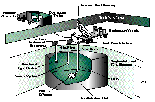
Robot arm gets into hard-to-reach places
 A remotely operated robotic device is being developed to be placed in underground storage tanks. The Light Duty Utility Arm system will characterize waste in-situ and determine the structural integrity of the tanks by performing in-tank inspections. LDUA will also be used for some types of waste sampling.
A remotely operated robotic device is being developed to be placed in underground storage tanks. The Light Duty Utility Arm system will characterize waste in-situ and determine the structural integrity of the tanks by performing in-tank inspections. LDUA will also be used for some types of waste sampling.
LDUA is being fabricated by SPAR Aerospace, Ltd., under contract with Westinghouse Hanford Company. LDUA brings technologies developed at multiple U.S. Department of Energy laboratories together into an integrated system.
Currently, tanks and their contents are characterized by lowering cameras, instruments, and sampling devices vertically into a tank on fixed supports. Equipment operation is limited to the area directly below the opening riser in the tank.
LDUA will be placed into tanks through a 12-inch diameter tank riser. The arm will provide seven degrees of freedom with a 13.5-foot reach for placing characterization end effectors in various locations within the tank. The system uses a stereoscopic camera providing basic structural and waste-level information. This camera will be replaced by a radiation-hardened camera system in fiscal year 1996.
LDUA consists of several components, including a robotic manipulator, deployment mast, and a containment housing. It also has a tank riser interface and confinement box, an operations and control trailer to house data acquisition and control computers, and a maintenance subsystem. An automated end effector exchange station will enable decontamination and exchange of the characterization end effectors.
The new cameras incorporate a laser range finder system and a structured light system. These cameras will enable researchers to characterize tank structural integrity and to topographically map the tank interior three-dimensionally. The new cameras will be able to remain inside the tank longer and will provide higher picture resolution.
For topographical mapping, the laser range finder, under development by Pacific Northwest Laboratories, will provide near real-time images of the tank interior and will be useful for supervisory control and surveillance during chemical characterization and waste retrieval operations. The structured light system is slower, but gives much finer resolution in all three dimensions. It may be deployed through single or multiple risers. The structured light system is being developed by Oak Ridge National Laboratory. The camera systems are scheduled to be complete by FY96.
Besides waste surface and contour, the camera systems give volumetric data which will assist in planning and executing waste characterization and retrieval operations, which will also be done robotically. Along with the cameras, software is being developed to aid in data acquisition.
Researchers are also developing water jet technology in order to retrieve equipment from inside the tank. The water jet technology will dislodge waste while simultaneously conveying the waste and used water to the surface. The system uses pneumatic conveyance. Water jet tools will minimize secondary liquid waste and are ideally suited for aging tanks because their operation causes no additional stress on structurally marginal tanks.
ORNL is scheduled to receive the first LDUA system in FY96. It will be used for gunite tank sample retrieval operations, characterization of tank waste, and for dislodging and conveying waste out of tanks using scarifying end effectors. Based on information collected at ORNL, the system may be modified prior to use at other locations. Pacific Northwest Laboratories at Hanford and the Idaho National Engineering Laboratory will also receive LDUA systems. The U.S. Department of EnergyOffice of Technology Development will set up an LDUA system as a test bed at either Hanford or Idaho. Idaho National Engineering Laboratory will use it for tank and waste characterization and sampling.

 A remotely operated robotic device is being developed to be placed in underground storage tanks. The Light Duty Utility Arm system will characterize waste in-situ and determine the structural integrity of the tanks by performing in-tank inspections. LDUA will also be used for some types of waste sampling.
A remotely operated robotic device is being developed to be placed in underground storage tanks. The Light Duty Utility Arm system will characterize waste in-situ and determine the structural integrity of the tanks by performing in-tank inspections. LDUA will also be used for some types of waste sampling.